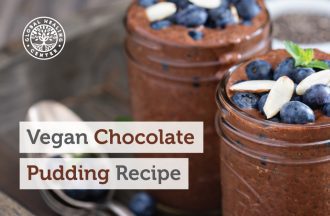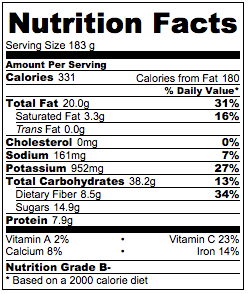Guest writer for Wake Up World
I hate to be a spoilsport but you know those little pudding cups that are a popular item in kids’ lunches? They’re not much more than neatly-packaged doses of refined sugar, dairy milk, and processed oil—not the best choice if you’re following or trying to instill healthy eating habits. Instead, consider trying this vegan chocolate pudding recipe I found on Oh She Glows. With a fruit-filled avocado, almond butter, and banana base, and no added sugar, it’s a healthy, nourishing, and delicious snack.
Demand for avocados has soared over the last few years. They’ve become so popular that you can find imported avocados on nearly every corner of the earth. Avocados taste amazing and, within recipes, make a healthy, versatile substitution for creamy ingredients like milk products. Unlike the saturated fat and naturally-occurring hormones present in milk[1, 2] (even organic milk), avocados provide an excellent source of monounsaturated fat, vitamins, and minerals. They even contain phytosterols, which actually inhibit the absorption of cholesterol.[3]
[pro_ad_display_adzone id=”110028″]
Avocados are a great source of phytonutrients and offer a range of health benefits. They’re dense in vitamins A, C, E, and K, and several B vitamins. The healthy mono- and polyunsaturated fat in avocados helps promote normal lipid profiles and increases the bioavailability of fat soluble vitamins and phytochemicals.[4] One study revealed that avocados contain a phytochemical, persin, that could potentially halt the progression of breast cancer.[5]
This pudding is full of healthy ingredients and makes a great dessert or snack. You can even pack a container with the kids’ lunch for a healthy alternative to the prepackaged pudding cups. Whatever you do, try to eat it up within a day. Fresh bananas and avocados taste best when they’re fresh.
Vegan Chocolate Pudding
- Prep time: 10 minutes
- Cook time: 0 minutes!
- Total time: 10 minutes
- Serves: 3
Equipment
- Food Processor
- Spatula
- Glass jars or containers
Ingredients:
- 3 organic 7” bananas with just a few brown spots, peeled and cut into ½ inch slices
- 1/2 medium organic avocado, cut horizontally from the stem, peeled and pitted
- 4 tbsp creamy, raw almond butter (for people with tree nut allergies, sunflower seed butter is a great alternative)
- 4 ½ tbsp raw, organic, unsweetened cocoa powder
- 1 tsp organic vanilla extract
- ¼ tsp pink Himalayan Crystal Salt or fine sea salt
Directions:
- Blend all ingredients in your food processor on high until you’ve reached the desired consistency. Pause occasionally to scrape down the sides of the bowl to mix any rogue ingredients clinging to the walls of the bowl.
- Using your spatula to mitigate any spills, pour small servings of pudding into glass jars or containers.
- Chill pudding in the fridge for at least an hour before serving.
- Eat within 24 hours for the best taste.
You Don’t Have To Feel Guilty About This Indulgence
It’s hard to imagine something could replace pudding and still be good for you, but the potassium content in bananas offers a level of support for cardiovascular health. Potassium supports normal blood pressure[5] by balancing your sodium-potassium ratio.[6, 7] Potassium is also an electrolyte, which is what makes bananas a fantastic whole food substitute for sweetened, artificially-colored sports drinks.[8] After your next run, reward yourself with this delicious pudding!
Try this sweet, creamy dish for yourself and let us know how it turned out! You can leave a comment below, or join the conversation on Facebook.
References
- Maruyama, K, T Oshima, and K Ohyama. “Exposure to exogenous estrogen through intake of commercial milk produced from pregnant cows.” Pediatrics international : official journal of the Japan Pediatric Society. 52.1 (2009): 33–8. Web. 16 Sept. 2016.
- Hartmann, Sonja, Markus Lacorn, and Hans Steinhart. “Natural occurrence of steroid hormones in food.” Food Chemistry 62.1 (1998): 20–7. Web. 16 Sept. 2016.
- Phytosterols. Linus Pauling Institute, 1 Jan. 2016. Web. 16 Sept. 2016.
- Dreher, Mark L., and Adrienne J. Davenport. “Hass Avocado Composition and Potential Health Effects.” Critical Reviews in Food Science and Nutrition 53.7 (2013): 738–750. Web.
- Butt, AJ, et al. “A Novel Plant Toxin, Persin, with in Vivo Activity in the Mammary Gland, Induces Bim-Dependent Apoptosis in Human Breast Cancer Cells.” Molecular cancer therapeutics 5.9 (2006): 2300–9. Web. 1 Nov. 2016.
- “Potassium and Heart Health Fact Sheet.” N.p.: International Food Information Foundation, Apr. 2011. Web. 16 Sept. 2016.
- “Sodium/Potassium Ratio Linked to Cardiovascular Disease Risk.” National Institutes of Health (NIH), 18 Mar. 2016. Web. 19 Sept. 2016.
- “Bananas are as beneficial as sports drinks, study suggests.” ScienceDaily, n.d. Web. 16 Sept. 2016.
About the author:
 Dr. Edward F. Group III (DC, ND, DACBN, DCBCN, DABFM) founded Global Healing Center in 1998 and is currently the Chief Executive Officer. Heading up the research and development team, Dr. Group assumes a hands-on approach in producing new and advanced degenerative disease products and information.
Dr. Edward F. Group III (DC, ND, DACBN, DCBCN, DABFM) founded Global Healing Center in 1998 and is currently the Chief Executive Officer. Heading up the research and development team, Dr. Group assumes a hands-on approach in producing new and advanced degenerative disease products and information.
Dr. Group has studied natural healing methods for over 20 years and now teaches individuals and practitioners all around the world. He no longer sees patients but solely concentrates on spreading the word of health and wellness to the global community. Under his leadership, Global Healing Center, Inc. has earned recognition as one of the largest alternative, natural and organic health resources on the internet.
For more information, please visit Global Healing Center.
Recommended articles by Dr. Edward Group:
- The Benefits of Apple Cider Vinegar
- Nutrition Facts Matter: What Food Labels Mean, and Why They’re Changing
- The 9 Best Fermented Foods for Your Gut
- 14 Foods that Cleanse the Liver
- Top 5 Foods for the Pineal Gland
- 6 Things You Must Know About Colloidal Silver
- The Importance of a Kidney Cleansing Diet
- The 9 Best Herbs for Lung Cleansing and Respiratory Support
- 7 Best Foods to Support Kidney Function
- Lung Cleansing With Peppermint Oil
- How Fluoride Damages Pineal Gland Health
- The Top 20 GMO Foods and Ingredients to Avoid – and Why
- How Does the Alkaline Diet Affect Gut Health?
- The Benefits of Apple Cider Vinegar
[pro_ad_display_adzone id=”110027″]








